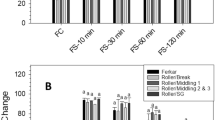Abstract
Wet- and dry-processing with and without heating treatments were used to dehull faba beans for preparation of flours from the cotyledons. Flour qualities were assessed by levels of tannin and trypsin inhibitor and other measures of proximate composition. High roasting temperature and shorter process time that improved the recovered cotyledon yields were verified significant by path analysis methodologies. In turn, the higher cotyledon recoveries correlated with higher protein levels and inversely with the measured tannin levels. Ash reductions were correlated to the wet processing options in hull removal while reductions in the insoluble dietary fiber were notably influenced by level of heating temperatures applied. Trypsin inhibitor levels ranged from 42 to 56% of the original with reductions tied to applications of wet and/or heat processing in each case improved by increased durations and temperatures of treatments.
Similar content being viewed by others
References
FAO (1988) Food and Agricultural Organization Production Yearbook. Rome, Italy: FAO.
Pomeranz Y (1970) Protein enriched bread. CRC Crit Rev Food Technol 1(3): 453–478.
Hoover W (1979) Use of soy proteins in baked food. J Am Oil Chem Soc 56(3): 301–303.
Reber EF, Eboh L, Aladeselu A, Brown WA, Marshall DD (1983) Development of high-protein low-cost Nigerian foods. J Food Sci 48: 217–219.
Lee JP, Uebersax MA, Zabik ME, Hosfield GL, Lusas EW (1983) Physicochemical characteristics of dry-roasted navy beans flour fractions. J Food Sci 48: 1860–1862.
Vaidehi MP, Kumari MS, Joshi N (1985) Sensory evaluation of cereal-pulse malt biscuits with high protein value. Cereal Foods World 30(4): 283–285.
Mustafa AI, Al-Wessali MS, Al-Basha OM, Al-Amir RH (1986) Utilization of cowpea flour and protein isolate in bakery products. Cereal Foods World 31(10): 756, 758–759.
Singh B (1990) Cereal-based foods using groundnut and other legumes. In: Uses of grain legumes. Patancheru, AP, P. India: ICRISAT.
Ory RL, Conkerton EJ (1983) Supplementation of bakery items with high protein peanut flour. J Am Oil Chem Soc 60(5): 986–989.
AOAC (1980) Official Methods of Analysis. Washington, DC: Association of Official Analytical Chemists.
AACC (1983) Approved Methods of the AACC. St. Paul, MN: American Association of Cereal Chemists.
Burns RE (1971) Method of estimation of tannin in grain sorghum. Agronomy J 63(3): 511–512.
SAS Institute, Inc. (1986) SAS® User's Guide. Raleigh, NC: SAS Institute, Inc.
Harvey WR (1990) User's Guide for LSMLMW and MIXMDL: Mix Model Least-Squares and Maximum Likelihood Computer Program PC-2 Version. Columbus, OH: Ohio State University.
Lukefahr SD, Cheeke PR, Patton NM (1990) Prediction and causation of litter market traits from preweaning and weaning characteristics in commercial meat rabbits. J Anim Sci 68: 2222–2234.
Cerning J, Saposnik A, Guilbot A (1975) Carbohydrates composition of horse bean (Vicia faba L.) of different origin. Cereal Chem 52(2): 125–138.
Ehiwe AOF, Reichert RD (1987) Variability in dehulling quality of cowpea, pigeonpea, and mung bean cultivars determined by tangential abrasive dehulling device. Cereal Chem 64: 86–90.
Marquardt RR, McKirdy JA, Ward T, Campbell LD (1975) Amino acid, haemagglutinin and trypsin inhibitor levels and proximate analyses of faba beans (Vicia faba L.) and faba bean fractions. Can J Anim Sci 55(3): 421–429.
Bhatty RS (1975) Trypsin inhibitors of faba beans (Vicia faba L.), 1: Preliminary studies. Can J Bot 53(24): 3075–3077.
Cowan JC (1979) Dry roasting of beans. J Am Oil Chem Soc 56: 168.
Yadav NR, Liener IE (1977) Optimizing the nutritive value of the protein of navy beans (Phaseolus vulgaris) by complementation with cereal proteins. Legume Research 1(1): 17–26.
Author information
Authors and Affiliations
Rights and permissions
About this article
Cite this article
Anderson, J.C., Idowu, A.O., Singh, U. et al. Physicochemical characteristics of flours of faba bean as influenced by processing methods. Plant Food Hum Nutr 45, 371–379 (1994). https://doi.org/10.1007/BF01088087
Received:
Accepted:
Issue Date:
DOI: https://doi.org/10.1007/BF01088087




